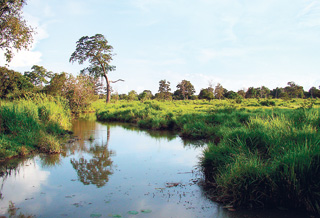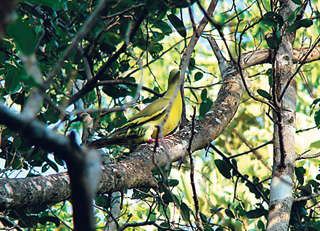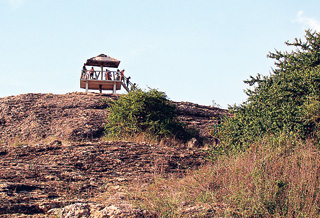It is 4 p.m. and we are driving through the Hurulu Eco Park at Habarana. It had rained the previous days and both the Kaudulla and Minneriya National Parks that we had planned to visit are under water. It was good to discover that we could drive through another wild life park during our short stay at Habarana.
This is the Hurulu Eco Park, part of the Hurulu Forest Reserve which comes under the purview of the Forest Department. Getting the information from a resident at Habarana, we found our way on the Habarana-Trincomalee Road. Coming from Habarana past the railway crossing after 100 metres you can see the Hurulu Eco Park board on your left, between the 116th and 117th km post.
At the moment the park covers an area of 10,000 hectares but there are plans for expansion. The area open to visitors is a drive of around 22 km from the Habarana end.
There are four waterways that run through the park and their sources are streams that have sprung up and joined together. Some are connected to the Hurulu Wewa. Thus the park has been named Hurulu Eco Park as all wild life here is sustained through these waters.
The waterways that run through the Hurulu Eco Park are invaluable to the many elephants we saw there. In the short drive of about one and half hours we saw around seven different groups of elephants in small herds of three, six and eight. The waterways are only about twelve feet wide and therefore a herd cannot bathe together, but Park Warden Randika Atapattu said plans were underway to start a project to make a large tank out of some abandoned small tanks.
There are teak plantations in the midst of the park, as well as the forest trees and shrubs. We spotted the crested Serpent Eagle, the Pompadour Green Pigeon and some other birds too far away to identify.
Conservator of Forests (Operations) K.P. Ariyadasa, told the Sunday Times that they had planned to open out this small area as an Eco Park for tourism and development while the rest the Hurulu Forest Reserve remained closed to visitors. This dry zone area has also been declared a “Man and the Biosphere reserve” by UNESCO, like the Sinharaja, Kanneliya and Knuckles Forests.
The Forest Department felt it was better to allow visitors to enter a designated area rather than keeping it closed altogether to the public, the Conservator explained.
Elephants move freely between the Anaulandawa Forest Reserve, the Kaudulla National Park, the Gal Oya Sanctuary, the Minneriya-Giritale Sanctuary and the Ritigala Strict Natural Reserve as all are in close proximity to each other.
There were tracks to come through the Hurulu Forest Reserve from Horowupotana side from Demata Wewa, close to Kahatagasdigiliya on the Anuradhapura-Trincomalee Road, although these were not yet developed. The Forest Department hopes to re-open these tracks which were closed during the war, as walking trails.
Mr. Ariyadasa voiced concern that some of the hired jeeps that bring in visitors get too close to the elephants, which could be very dangerous. “We noticed this happening, especially jeeps which had foreign visitors. As there is no system of having trackers accompanying visitors in the vehicles unlike in the National Parks, there is a danger here,” he said.
As we drove around the Eco Park we noticed two instances where drivers of a pick-up truck and a jeep had taken the vehicles off the road and into a thicket a few feet away from the feeding elephants. The vehicles were parked very close, backing the elephants, so close it seemed they wanted a cheap thrill of getting the elephants to charge. Both vehicles were carrying foreign visitors.
Since there were no trackers, this risky business of going off road was taking place. Perhaps the Forest Department will have to lay down some regulations and see that jeep drivers do not endanger the lives of visitors.
Getting too close to animals is tantamount to "obstruction to their free-living" - a violation in terms of the Fauna and Flora Ordinance of Sri Lanka.
Like in other wild life parks, we were allowed to stretch our legs at one point on a rocky slope where a log cabin had been built, affording the visitor a panoramic view. Narrow logs as steps led to the top. The wind tugged at our clothes as we stood gazing through the park from this vantage point.
Warden Atapattu says that all other animals found in the country’s wild life parks are found here. The park had been declared open on February 16, 2008, with little fanfare. More development work is planned like a visitor information centre and the building of the tank. |




